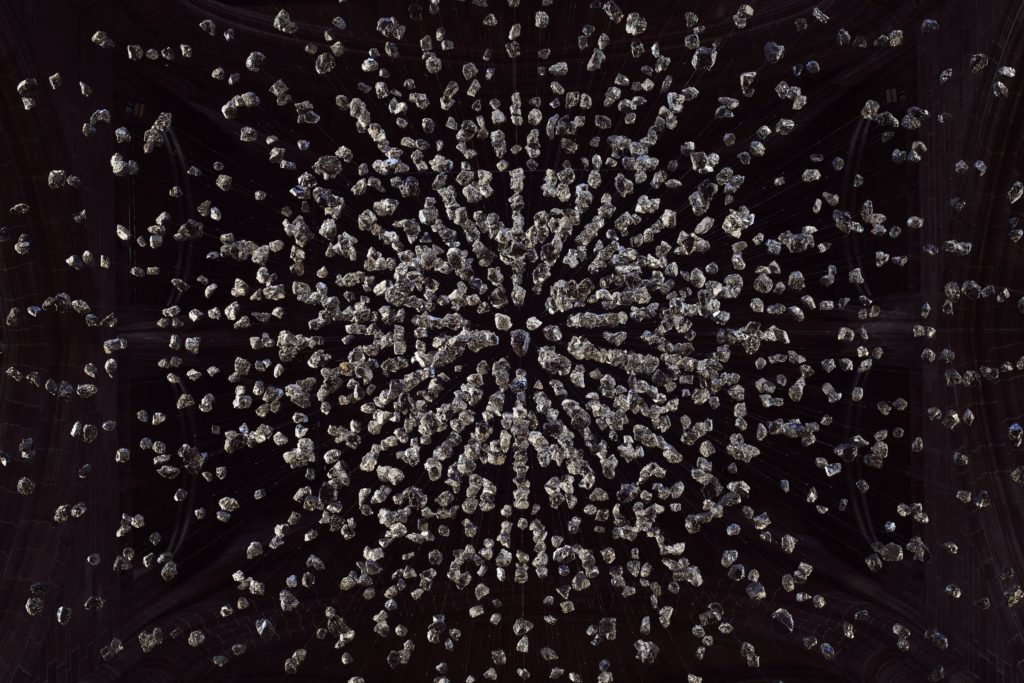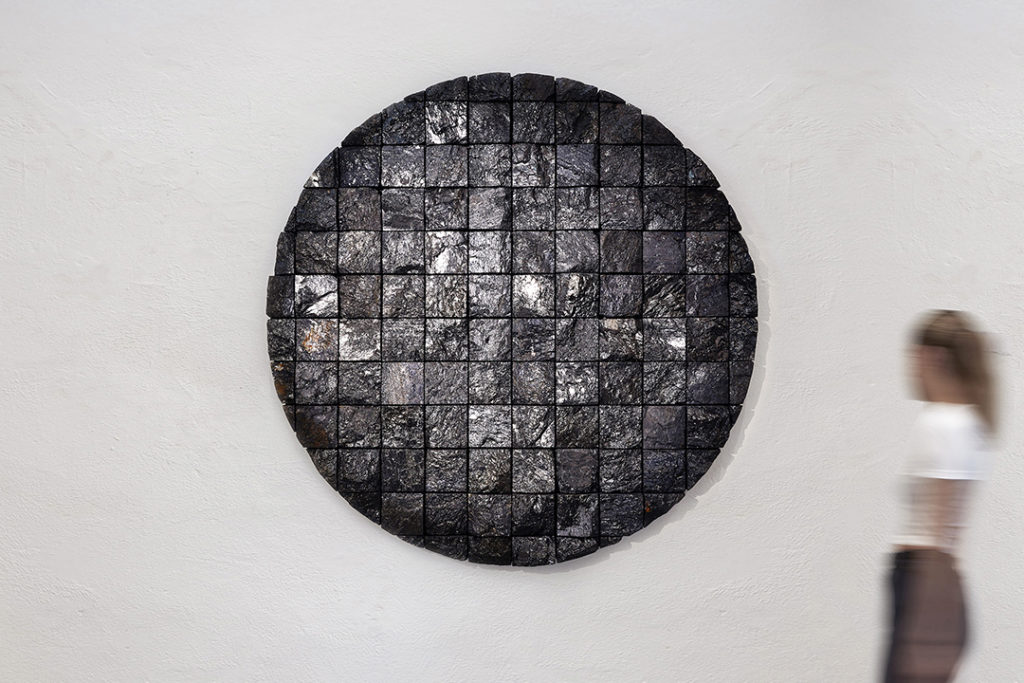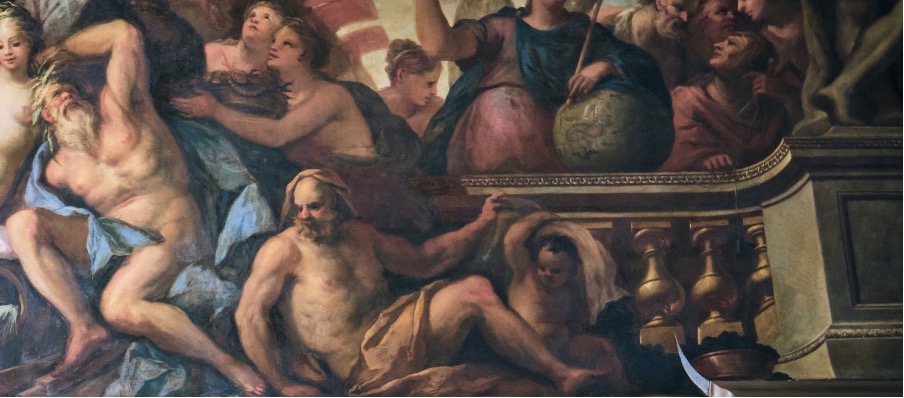Coalescence in the Painted Hall
Navigate this page to learn more about the artwork, and the history of coal in Britain and Greenwich.
Coal in Britain
During the 1500s and 1600s Britain’s basic fuel supply, wood, was replaced by coal. Wood supplies dwindled as the population grew and with it the demands of industry and agriculture. Between the 1540s and the 1620s the price of firewood increased ten-fold.
North East England became the primary coal-producing region for London. By the 1700s ‘Newcastle Coal’ was being brought down the east coast by sea in large quantities. The production and transportation of coal involved approximately 600 ships and a diverse workforce, including miners, seamen, lightermen, wholesalers, retailers, and agents.
Taxes on coal were introduced, initially for specific projects such as rebuilding London after the Great Fire of 1666. Later, these taxes were extended for long-term purposes, including funding the Royal Hospital for Seamen at Greenwich.
The development of steam power significantly increased the demand for coal: production peaked in 1913 at 292 million metric tons. The coal industry employed 1.2 million people by 1920, approximately 1 in 20 of the UK workforce. From the 1940s, coal mining declined due to exhausted seams and the rise of alternative energy sources like North Sea gas.
Coal in the Painted Hall ceiling
If you look closely at the western end of the Lower Hall ceiling, you will see a figure pouring a sack of coal into a golden bowl. James Thornhill, artist of the Painted Hall, noted that the figure represents the River Tyne in North East England: ‘The River TINE is there pouring forth his plenty of Coals’. It is possible that Thornhill highlighted this in his Explanation of the Painted Ceiling to acknowledge that the Royal Hospital for Seamen was receiving funding from the coal tax.
In 1711, the Fifty New Churches Act prompted an increase on the duty on coal brought into the Port of London. This Act was extended to include a £6,000 annual payment to the Royal Hospital for Seamen ‘for continuing the building, begun and lying unfinished’ and for building a chapel.
Also pictured on the Painted Hall ceiling is an elderly man representing Hiems (Winter), warming his hands above a brazier of coal. The model used to depict Hiems was John Worley, one of the first Pensioners to enter the Hospital in 1705 after spending some 70 years at sea. Before joining the Navy, Worley is thought to have worked in the coal trade.
Find out more about the Painted Hall
Coalescence
Year: 2023
Material: Anthracite, Stainless Steel Wire, Light
Location: The Painted Hall at the Old Royal Naval College
Coalescence was developed by Paul Cocksedge and supported by Carpenters Workshop Gallery to question our relationship with, and dependence on, fossil fuels. A single 200W light bulb, turned on for a year, would consume over half a tonne of coal – Coalescence represents that same amount. This sculpture is made up of 2,500 pieces of anthracite, which is a form of high carbon coal that has a lustrous quality when illuminated.
‘These pieces feel apt, considering the current conversations around energy consumption,’ says Cocksedge. ‘As a maker, it was important for me to go to the source and be part of the excavation process. I spent months hand-drilling each piece of coal, which gave me a new appreciation for the beauty of working with natural materials. It’s easy to forget the origins of the energy that’s required in almost every aspect of our lives.’
Find out more about Paul Cocksedge Studio

20 Trees
Year: 2023
Material: Anthracite
Location: The Nelson Room at the Old Royal Naval College
20 Trees, an artwork by Paul Cocksedge, blends mathematics with environmental awareness. Using anthracite blocks, the sculpture subtly conveys a message about ecological balance: if the sculpture was burned, it would take 20 trees an entire year to offset the carbon emissions produced. Together, the sculptures Coalescence and 20 Trees stand as a gentle reminder of the critical balance between human actions and environmental stability.
We want this exhibition to be an opportunity to reflect and to consider the ways in which our relationship with the natural world can be improved. Therefore, we invite you to take a photo and post it with your reflections, tagging us on socials and using the hashtags below.
Find out more about Paul Cocksedge Studio

Preservation
This site has a long and celebrated 600-year history. As its custodian, it is the mission of The Greenwich Foundation for the Old Royal Naval College to enrich people’s lives by protecting this architectural masterpiece and sharing its history, heritage, and significance, contributing to the enjoyment and wellbeing of everyone.
Ensuring that we conserve our rich heritage for current and future generations is one of our core charitable objectives. Every year we carry out around 10,000 hours of conservation work at the Old Royal Naval College, and it costs over £3 million per year to maintain our site.
We recognise that the ability to continue to conserve and share our history is intrinsically linked with our impact on the environment and the effects of climate change.
Read our Environmental Statement of Intent and find out more about how you can support us




